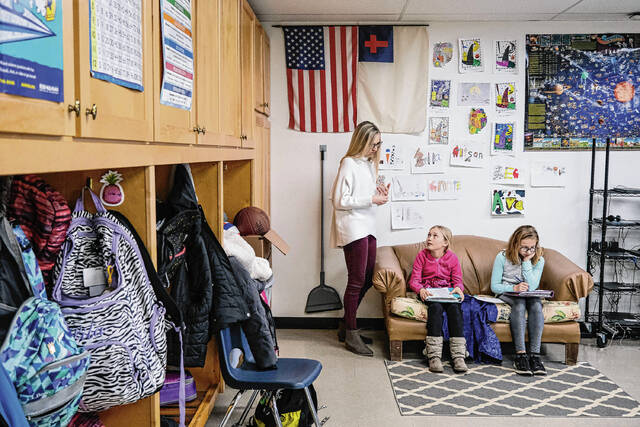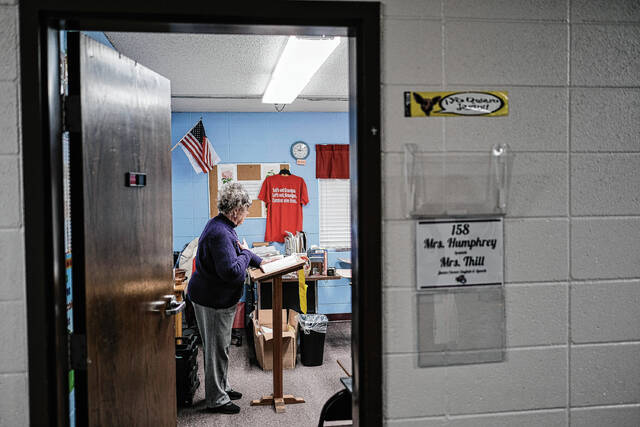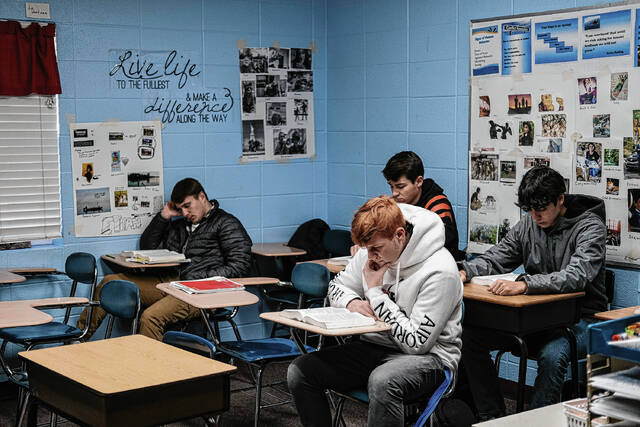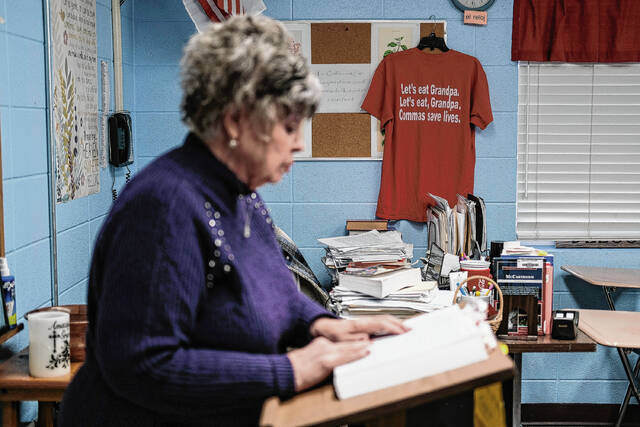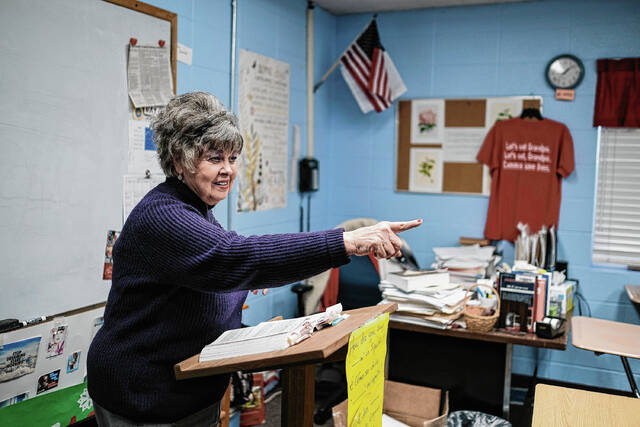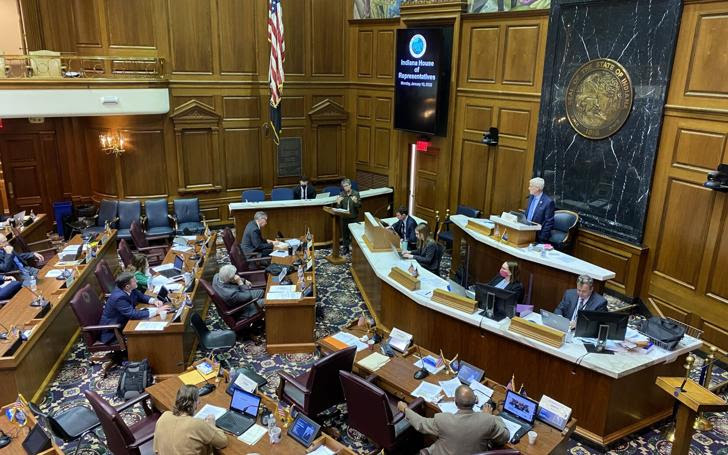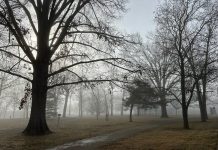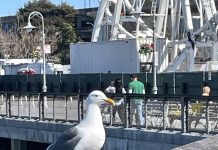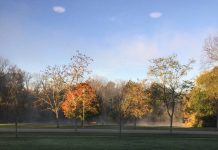Massive Arctic icebergs crop up to form a nearly impenetrable blockade.
Deep orange sandstone canyons need to be navigated to have any success. And don’t underestimate the scourge of out-of-control squirrels.
The newest artwork at the Indianapolis Museum of Art brings nature and ecological issues, such as the disappearance of Indiana’s prairies and the fragile state of our rivers, to life.
But it’s hard to be too serious when you’re literally putting around the issues.
[sc:text-divider text-divider-title=”Story continues below gallery” ]
The world of high-brow art intersects with backyard entertainment with opening of the Indianapolis Museum of Art mini golf course. Local and national artists have been recruited to create whimsical holes inspired by the natural world.
People are able to tackle all 18 holes, playing around uniquely designed sculptures that — for once — people are encouraged to touch.
“The interactivity and playfulness of it, while still being
[sc:pullout-title pullout-title=”If you go” ][sc:pullout-text-begin]
Mini Golf at the IMA
What: A putt-putt course laid out on the grounds of the Indianapolis Museum of Art, with holes designed by local and national artists.
When: Through Sept. 3
Hours: 11 a.m. to 5 p.m. Tuesday, Wednesday, Friday and Saturday; 11 a.m. to 9 p.m. Thursday; noon to 5 p.m. Sunday
Where: 4000 Michigan Road, Indianapolis
Cost: Play is included in museum admission, $18 for adults and $10 for youth ages 5 to 17. Kids under 5 are free. During special free admission days, the public can play the course for $8. Mini golf is free to members.
Information: imamuseum.org
[sc:pullout-text-end][sc:pullout-title pullout-title=”At a glance” ][sc:pullout-text-begin]
Navigating Mini Golf at the IMA
This year’s mini golf course at the Indianapolis Museum of Art features themes playing off the natural world. Here’s what players can expect from each hole as they tee off:
To Bee or Not to Bee
Artists: Tom Loftus and Robin Schwartzman
What: The hole explores nature’s greatest pollinator, the honeybee, and brings attention to the frightening decline bee populations have seen in recent years. Players will have to navigate their golf balls through a beehive in order to find the honeycomb hole.
Stroll Gardens
Artist: Kevin Bielicki
What: Brings the “miniature” to mini golf with a fun play on Japanese gardens, which are famous for appearing bigger than they are thanks to the careful landscape design. This hole draws on those same ideas to create a larger feeling of place.
A Forest of Sound
Artist: Luke Crawley
What: Crawley invites you to putt with your ears as well as your hands in this sonically interesting experience — a take on humans’ earliest attempts at creating musical instruments.
Jungle PARadise
Artist: William Denton Ray
What: Players are taken on a whimsical jungle journey where they will encounter a geometric giraffe, an elephant in a top hat and a playful monkey. The hole itself is carefully guarded by the king of the jungle.
Shadow-Tailed Scourge
Artists: Beth and Chad Eby
What: A returning feature from last year’s course, the hole hearkens back to the “Great Squirrel Invasion” of 1822 when a westward migration of squirrels decimated crops in Indiana. Golfers will have to putt around five giant squirrels in order to find the hole.
Canyonlands
Artist: Sam Welch
What: This course pays homage to the rich red-orange sandstone featured in most of Utah’s state parks. Will players try to traverse the canyon ridge path, or take their chances in the river below?
WaterPLAY
Artists: Jason Wolfe and Veronica Vela
What: Designed to look like an Indiana wetland, this course has an undulating playing surface littered with fish, cattails, and rocks. Golfers who manage to putt through those obstacles will have to deal with a beaver lodge in order to find the hole.
Geology of Indiana
Artist: Brent Aldrich
What: This hole derives its inspiration from the Geologic Record in Indiana, represented in the bedrock geology and fossil record. Golf balls will roll over a hand-drawn cutout depicting millennia in both bedrock geology and surficial topography, and players will have to navigate past a mastodon skeleton before putting into a limestone cave.
15-1
Artist: Colin Tuis Nesbit
What: Prairielands used to cover 15 percent of Indiana, but that number has since been reduced to just 1 percent. Learn more about prairies and the grasses indigenous to Indiana and see what is being done to conserve what prairieland is left in the Hoosier state while playing this hole.
Stumped
Artists: Students of Noblesville High School’s Sculpture II class
What: This hole shows that a tree can provide life to its surrounding ecosystem even after it dies and begins decomposing. While standing, trees are usually a bane of golfers; this hole will give participants a new appreciation for trees.
2058: The first mini golf hole without ice
Artists: Luke Crawley and Quincy Owens
What: A journey to what the future might look like if glaciers continue to melt as a result of climate change. Golfers will have to navigate past several icebergs full of mirrors and transparent panels that will show how changing conditions have affected our world.
Pond Life
Artists: Beth and Chad Eby
What: The hole features a replica of Paramecium caudatum, an extremely common single-celled organism found in fresh and salt water, including in the pond at the museum’s 100 Acres art and nature park.
White River Putt
Artist: Alan Goffinski
What: Goffinski has created a hole replicating the White River watershed and players will move their golf balls down the various tributaries that make up the Indianapolis area river and stream network.
The Carpet is Hot Lava
Artist: Martin Kuntz
What: The hole depicts a giant Triceratops being submerged by lava with an erupting volcano in the background. Kuntz said the hole design hearkens back to his childhood and tries to capture the destruction and chaos in a lighthearted way.
Cardinal 200
Artist: William Denton Ray
What: A mashup of Indiana’s state bird, its agricultural heritage and the iconic Greatest Spectacle in Racing, this hole celebrates all things Hoosier.
Poplar Mechanics
Artist: Gautam Rao
What: Take a quaint, shaded stroll through a forest inspired by Indiana’s state tree, the tulip poplar. This hole celebrates Indiana’s woodlands and attempts to recreate the experience of walking through the forests of Brown County.
Putting Around Africa
Artist: Scott Shoemaker
What: This hole serves as a tiny tour of Africa and features some of the animals, pictographs and signage someone might see in the African bush.
Reflections in the Forest
Artist: Suzy Slater
What: Enjoy a little bit of shade thanks to carefully placed tree canopies as players navigate past tree stumps and limbs. Inspired by acreage from Slater’s own family farm, this course recreates the feel of the forest on a golf course.
— Information from the Indianapolis Museum of Art
[sc:pullout-text-end]

